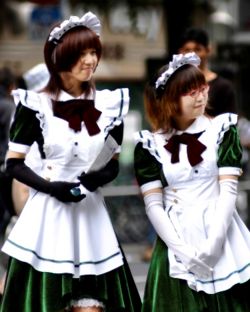Japanese popular culture

Photo © by Sonny Santos, used by permission.
Japanese popular culture is a highly distinct collection of fashions, art, music and other forms of expression. While young Japanese often follow fashion trends from overseas, they have also developed their own trendy subcultures that to outsiders may border on the bizarre - teenagers dressed in maid outfits or in cute Victorian-style 'Lolita' costumes are more common a sight in Tokyo than traditionally-dressed maiko (妓) girls in historic Kyoto. Template:TOC-right Popular culture in Japan not only reflects the attitudes and concerns of the present but also provides a link to the past. Popular films, television programmes, comics, and music all developed from older artistic and literary traditions, and many of their themes and styles of presentation can be traced to traditional art forms. Contemporary forms of pop-culture, much like the traditional forms, provide not only entertainment but also an escape for contemporary Japanese from the problems of an industrial world.
Entertainment

Photo © by Sonny Santos, used by permission.
Although Japan is often thought of as a hard-working society with little time for pleasure, the Japanese seek entertainment wherever they can. It is common to see Japanese commuters riding the train to work, enjoying their favourite manga (漫画 'comic') or listening through earphones to the latest music on portable players. There is a wide range of music, films, and the products of a huge comic book industry, among other forms of entertainment. Game centres, bowling alleys, and karaoke (カラオケ, 'empty orchestra') are popular for young people, while older people may play shogi or go in specialised parlours.
Leisure time

Photo © by Sonny Santos, used by permission.
When asked how they spent their leisure time, 80% of a sample of men and women surveyed by the government in 1986 said they averaged about two and a half hours per weekday watching television, listening to the radio, and reading newspapers or magazines. Some 16% spent an average of two and a quarter hours a day engaged in hobbies. Others spent leisure time participating in sport, socialising, and personal study. Teenagers and retired people reported more time spent on all of these activities than did other groups.